
TL;DR for Titanic: A Space Between
(played on a Meta Quest 3 128 GB model)
| Pros | Cons |
| + Excellent graphics | – Boring gameplay |
| + Very creepy monsters for horror fans | – Clunky base mechanics |
| – Inconsistent in-game logic | |
| – Nausea-inducing |
Editor’s note: This game is currently available through Meta’s App Lab, and may be experimental or still in development.
Dear reader,
I am honour-bound by truth to inform you that I found this game nothing short of grueling.
It feels bad going into this review knowing that I have mostly negative things to say about a piece of art developed painstakingly—for years—by a team of only two!
But it would feel worse to lie about it.
Know, dear reader, that I approach every new game I play with an attitude of charity and hope.
I want it to be good! I pick the ones that look good—on purpose!
But unfortunately, playing “Titanic: A Space Between” is like dating a hot, mean idiot.
She’s lovely to look at, but—try as you might to hold out for a real connection (she’s so hot)—whenever you go to say something she interrupts you with another niche TikTok her friend sent her.
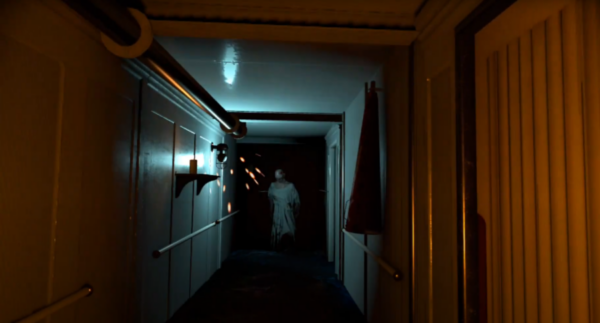
Does she understand that this is supposed to be a date?
Does Titanic: A Space Between understand that it’s supposed to be a videogame?
STORY
I’m convinced that Titanic: A Space Between would have been much better off as a VR “experience.” A historical sci-fi horror piece, A Space Between could have leveraged its stronger aspects by ditching its grinding, glitchy, unintuitive, unresponsive, uninspired, DOWNRIGHT SICKENING—sorry.
Sorry. I’m good.
One sec…
Yeah, I’m good… Wooh!
I’m good.
It could have ditched the gameplay altogether and just rested on its impressive aesthetics is all I’m trying to say here…
Where we could have had an immersive, first-person horror movie set aboard the legendary RMS Titanic, we instead get to eat wet garbage with a spoon from one of the Meta Quest 3’s most beautifully rendered trash bins.
Before I continue the violent cycle of abuse that A Space Between has now cursed my lineage with, I’ll explain this game’s premise so we’re on the same page:
You play as two forgettable protagonists, one male and one female.
You begin the game proper as the male protagonist, waking up in a room.
Your hands are absolutely disgusting for some reason.
It is explained to you by a JARVIS-like comms master that you are going back in time to investigate three mysterious disappearances centered around the RMS Titanic. There was a time anomaly, and somehow an original passenger from the Titanic has wound up in our time. In response to this anomaly, time travel was banned, and the inventor of the technology disappeared.
Another time traveler (female protagonist) sent to investigate the ship has also disappeared, but you—you daring renegade male protagonist—and your comms master are determined to get to the bottom of things!
Our perspective switches, chapter to chapter, between male protagonist and female protagonist as they slowly unravel the paranormal ramifications of messing with space-time and ghost ships.
How the story ends I won’t spoil and also don’t know because I couldn’t get through it.
Thankfully, around three-quarters into my playthrough, the good Lord blessed me with a game-breaking bug, liberating me from my obligation to carry on any further.
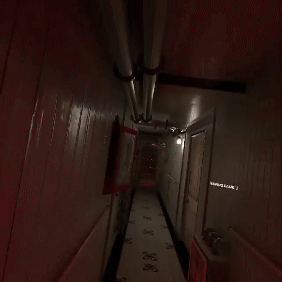
GAMEPLAY
Titanic: A Space Between is played by walking and crawling through rooms, halls, and vents, and bringing items to places.
Yes, the whole of the gameplay is exploration and fetch quests.
Move here.
“Oops, we didn’t expect this!” says comms (again).
“You’ll have to find an item to bring it to a place!” comms continues between spirited bouts of vomiting exposition.
Repeat.
Every time you start to get some momentum—every time you try to play the game—the game tells you “No! We don’t do that! We look for item and bring it to place!” pointing fervently to those exact words tattooed in bold across its forehead.
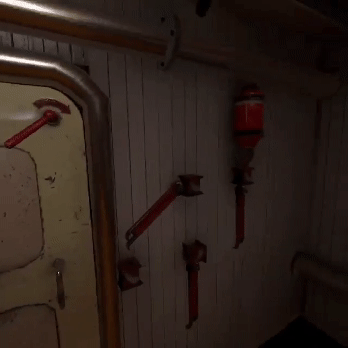
Being a horror game, nearly everything is dark.
Your primary device—your main tool that you use to interact with the world aside from your hands (more on those later)—is, in part, a flashlight.
Shortly into the game your invisible power-tether to HQ is spookily intercepted, leaving you to collect analog batteries stashed all about the ship to keep your flashlight working.
Now it must be said that having your primary resource suddenly become scarce ramps the horror element way up! And since that resource is light itself, you’re forced to choose when to wander these haunted halls in utter darkness, and when you must—either out of necessity or fear—turn on your flashlight.
In a vacuum, that’s just good game design.
I’m scared and that’s you delivering on your promise, Titanic: A Space Between. Nicely done.
However, when the main thing you—the player and purchaser of a videogame—are to do is search aimlessly for items, doors, and vents, not being able to see becomes a real issue.
Luckily, holding your hand over your primary device will show you your objective in the form of a frustratingly unhelpful sentence:
“Find your way to floor F.”
“Find a key to open the padlock.”
“Progress in the game.”
“Continue.”
Well okay, I guess I’ll keep looking around in the dark until I happen to find whatever totally unintuitive place you’ve hidden my capacity for joy in, Titanic: A Space Between.
Oh, behind one of the crates that are usually unmoveable set pieces?
But this one I can push?
Of course. Yes. Why wouldn’t that be true?
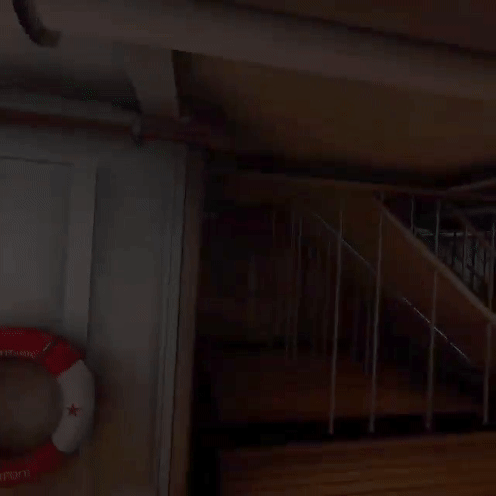
This game literally just hides things from you in the dark with little to no clues about where to look. The only guidance you get is just your device saying “Go do.” And more than once it defies the expectations that it itself has set vis-a-vis what is or is not an interactable bit of the game.
Another related way this insidious torture device of a game fools you is with doors!
Oh, man.
So at one point, I needed to find a blunt object to break open a door to get to a knife to cut a rope to open another door (this is gameplay).
And after about twenty minutes of my real, precious human life on Earth spent looking around, I realized that there was a suitcase right there on the ground in one of the main rooms that I had been scouring!
I’ve picked up these exact copy-pasted assets before!
How did I not notice this?
“What a fool I’ve been!” I thought to myself, dropping to the ground to pick it up because that one new standard (and I think still unnamed) VR mechanic of simply raising your hand above the item on the floor and then grabbing is far beneath the deep immersion of this janky VR title.
Nothing.
No movement, no capacity to hold the suitcase whatsoever.
The game had decided that I needed to find a different, specific blunt object in a different room, and that this room needed a suitcase—that looked just like the previous ones I had picked without problem—for decoration.
Another related way this insidious torture device of a game fools you is with doors!
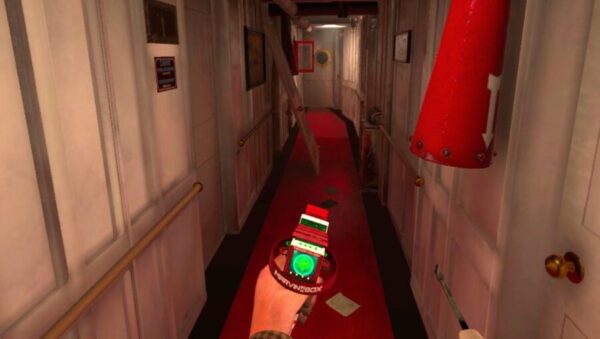
Nearly every door, whether you can go through it or not, looks exactly the same.
And since finding your way around is core gameplay, you can expect to be attempting to open lots and lots of decorative doors with graspable handles.
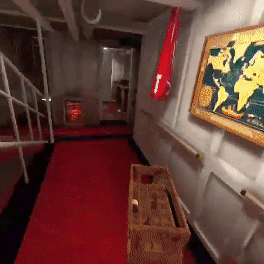
Graspable handles actually might be a bit too generous of a description however, since grabbing things correctly (which is essential to literally every aspect of in-game interaction aside from movement) is a big ol’ toddler-hands jank fest.
Why do I have to negotiate with my own hands!?
This is a constant problem in a ton of ways:
Even something as simple as hot-swapping between your only two items stored over either shoulder is an immersion-breaking chore.
Often you’ll distinctly reach to one of your shoulders to grab its associated item but continue to get the wrong one. So you then have to pull that wrong one out and hold it far enough away from your other hand that when you attempt to grab with your empty hand it doesn’t just snap to also grasp whatever wrong thing is in your full hand.
There’s not even any benefit to holding something with two hands!
Why am I allowed to do it? It keeps getting in the way of the thing I’m actually trying to grab!
Why do I have to negotiate with my own hands!?
While this is pretty annoying most of the time, it’s a downright malady in the few scattered action sequences: Operating pulleys and valves to ascend from a rapidly flooding basement; swinging open a door and quickly closing it behind you to escape a horrific spider-legged humanoid creature—These things require dexterity and fluid movement!
Every aspect of the game is deeply affected by the difficulty of grasping items and handles.
And it’s painfully plain to see that right underneath this thin but unfortunately dense layer of clunky mechanics are genuinely thrilling, action-packed payoffs to the slow, creeping pace set by the rest of the game.
VERDICT
Bad level-design. Poorly executed basic mechanics. A constant battle to stop your character from getting stuck inside walls. Inconsistencies between what is and isn’t interactable (including plenty of invisible walls to also get stuck in).
I could complain about my experience for another thousand words and still have more to say, but I think I’ve made my point.
We’ve covered the biggest problems now. So instead of airing out every single piece of dirty laundry, let’s end on the positives.
It must be noted that I played on a pre-release build of this game*, and—while there are certainly some other issues already mentioned—the great majority of my bad experience with it comes down to frustrating base controls; an issue that cascades into myriad other problems.
*(Editor’s note: Specifically, the version reviewed here was Version 1.01 and labelled a “work in progress build” dated October 2023)
Should these get fixed, then this whole review changes.
Every aspect of the game is deeply affected by the difficulty of grasping items and handles.
This point I can’t make clear enough.
… the folks at Globiss Interactive have done an incredible job with light and shadow, particle effects, and water physics
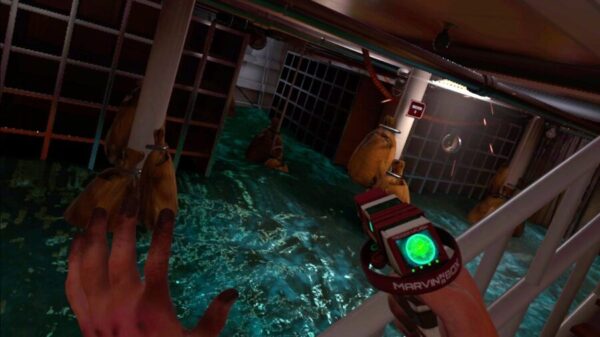
There is massive room for improvement here.
Fix grabbing. Patch some bugs. Sort some collision issues. Add some heft to all of the otherwise seemingly weightless items and who knows how this visual marvel might start to actually play?
Yes, there are some issues with certain muddy textures and some intrusive shifts in draw-distance, but this game really is mostly quite beautiful.
Just walking around and taking in the eerie sights of that legendary vessel—in all its historical accuracy—is chilling.
To that end, the folks at Globiss Interactive have done an incredible job with light and shadow, particle effects, and water physics, pushing the Quest hardware to its limit.
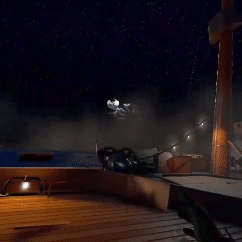
This two-person team is clearly dedicated to their art, and I sincerely hope that this is a stepping stone for them to achieve greater things.
Globiss, don’t get discouraged by critics like me whose main goal is to inform and entertain an audience. Your herculean effort does not go unnoticed.
And when you guys do graduate to running a team that can work out your bugs and playtest and iterate on behalf of your vision—I just know that you’ll make something epic.
But for now—for this game as is—we give Titanic: A Space Between a 3/10.
Scoring & Rubric
Scores are out of 10, where 10 is a masterpiece, 1 is unplayable, and 5 is just average.
Gameplay has a heavier weighting in the overall score.
Gameplay – 2
Immersion – 3
Visuals – 8
Sound – 5
Performance – 2
Replayability – 4*
*Replayability here has been bumped up two points for the history buffs and nautically inclined by the presence of an unlockable Titanic “exploration” mode.
Image credit: Globiss Interactive / Titanic: A Space Between
About the author
Kierkegaard once said that the artist is like one stuck inside Phalaris' brass bull, which burned up its victims and—due to the formation of its apertures—made beautiful music from their anguish.
The critic, he said, is just like the artist except he doesn't have the anguish in his heart nor the music on his lips.
A lifelong gamer based out of Vancouver, Pelé disagrees with Kierkegaard.
